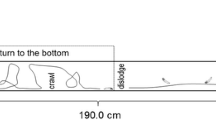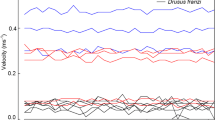Abstract
Microhabitats occupied by larvae of 12 species or complexes of black flies at 30 sites in western Canada were investigated for fluid flow parameters. An attached boundary layer was a feature of almost all microhabitats occupied by larvae of black flies. Although not measured directly, acceleration of water resulting from flow around an object appeared to alter flow characteristics and make microhabitats more favourable. This predictability in the flow characteristics of microhabitats occupied by larvae of black flies implies that the contagious dispersion of these larvae is a response to the heterogeneity of flow over a stream bed. It is suggested that microhabitats characterized by suitable flow characteristics may constitute a resource that limits population size. Larvae occupied microhabitats with both laminar and turbulent boundary layers, and were found in microhabitats with a wide range of water velocities. Mainstream flow parameters investigated were; water velocity, water depth, and whether flow was subcritical, critical or supercritical. Boundary layer parameters investigated were; whether flow was laminar or turbulent, and the point at which separation from the substratum occurred.
Similar content being viewed by others
References
Badri Narayanan, M. A. & V. Ramjee, 1969. On the criteria for reverse transition in a two-dimensional boundary layer flow. J. Fluid Mech. 35: 225–241.
Braimah, S. A., 1987. The influence of water velocity on particle capture by the labral fans of larvae of Simulium Malloch (Diptera: Simuliidae). Can. J. Zool. 65: 2395–2399.
Brenner, R. J. & E. W. Cupp, 1980. Rearing black flies (Diptera: Simuliidae) in a closed system of water circulation. Tropenmed. Parasit. 31: 247–258.
Chance, M. M. & D. A. Craig, 1986. Hydrodynamics and behaviour of Simuliidae larvae (Diptera). Can. J. Zool. 64: 1295–1309.
Colbo, M. H. & G. N. Porter, 1979. Effects of the food supply on the life history of Simuliidae (Diptera). Can. J. Zool. 57: 301–306.
Colbo, M. H. & G. N. Porter, 1981. The interaction of rearing temperature and food supply on the life history of two species of Simuliidae (Diptera). Can. J. Zool. 59: 158–163.
Craig, D. A., 1987. Some of what you should know about water or, K.I.S.S.* for hydrodynamics (*Keeping It Stupidly Simple). Bull. n. am. benthol. Soc. 4: 178–182.
Craig, D. A. & M. M. Galloway, 1987. Hydrodynamics of larval black flies. In K. C. Kim & R. W. Merritt (eds), Black flies: Ecology, Population Management, and Annotated World List. The Pennsylvania State University. University Park, PA.: 171–186.
Currie, D. C., 1986. An annotated list of and keys to the immature black flies of Alberta (Diptera: Simuliidae). Mem. entomol. Soc. Can. 134.
Décamps, H., G. Larrouy & D. Trivellato, 1975. Approche hydrodynamique de la microdistribution d'invertébrés benthiques en eau courante. Annls. Limnol. 11: 79–100.
Eymann, M., 1991. Dispersion patterns exhibited by larvae of the black flies Cnephia dacotensis and Simulium rostratum (Diptera: Simuliidae). Aquatic Insects 13: 99–106.
Hall, F., 1974. A key to the Simulium larvae of southern California (Diptera: Simuliidae). California Vector News 21: 65–71.
Harrod, J. J., 1965. Effect of current speed on the cephalic fans of larva of Simulium ornatum var. nitidifrons Edwards (Diptera: Simuliidae). Hydrobiologia 26: 8–12.
Hart, D. D., 1986. The adaptive significance of territoriality in filter-feeding larval blackflies (Diptera: Simuliidae). Oikos 46: 88–92.
Hocking, B. & L. R. Pickering, 1954. Observations on the bionomics of some northern species of Simuliidae (Diptera). Can. J. Zool. 32: 99–119.
Kurtak, D. C., 1978. Efficiency of filter-feeding of black fly larvae (Diptera: Simuliidae). Can. J. Zool. 56: 1608–1623.
Lacoursière, J. O., 1989. Suspension-feeding behaviour of black fly larvae (Diptera: Simuliidae): Hydrological perspectives. Ph. D. Thesis. University of Alberta, Edmonton, Alberta.
Lewis, D. J. & G. F. Bennett, 1975. The blackflies (Diptera: Simuliidae) of insular Newfoundland. III. Factors affecting the distribution and migration of larval simuliids in small streams on the Avalon Peninsula. Can. J. Zool. 53: 114–123.
Maitland, P. S. & M. M. Penney, 1967. The ecology of the Simuliidae in a Scottish river. J. Anim. Ecol. 36: 179–206.
Mason, G. F., 1982. Cytological studies of sibling species of Simulium tuberosum (Lundström) (Diptera: Simuliidae). Can. J. Zool. 60: 292–303.
Mansingh, A. & R. W. Steele, 1973. Studies on insect dormancy. I. Physiology of hibernation in the larvae of the blackfly Prosimulium mysticum Peterson. Can. J. Zool. 51: 611–618.
McCreadie, J. W. & M. H. Colbo, 1991. A critical examination of four methods of estimating the surface area of stone substrate from streams in relation to sampling Simuliidae (Diptera). Hydrobiologia 220: 205–210.
Newbury, R. W., 1984. Hydrologic determinants of aquatic insect habitats. In V. H. Resh & D. M. Rosenberg (eds), The Ecology of Aquatic Insects. Praeger Publishers. Toronto, Ont.: 323–357.
Osborne, L. L., E. E. Herricks & V. Alvian, 1985. Characterization of benthic microhabitat: An experimental system for aquatic insects. Hydrobiologia 123: 153–160.
Osborne, L. L. & E. E. Herricks, 1987. Microhabitat characteristics of Hydropsyche (Trichoptera: Hydropsychidae) and the importance of body size. J. n. am. benthol. Soc. 6: 115–124.
Pope, A., 1954. Wind-tunnel Testing. John Wiley and Sons, Inc., New York. 511 pp.
Rühm, W. & M. Pegel, 1986, Die Substratbesiedlung durch Kriebelmückenlarven und -puppen (Simuliidae, Dipt.). Arch. Hydrobiol. 107: 75–87.
Schlichting, H., 1979. Boundary-Layer Theory. McGraw-Hill Book Company. Toronto, Ont. 817 pp.
Simmons, K. R. & J. D. Edman, 1981. Sustained occupation of the black fly Simulium decorum Walker (Diptera: Simuliidae). Can. J. Zool. 59: 1–7.
Van Dyke, M., 1982. An Album of Fluid Motion. The Parabolic Press. Stanford, CA. 76 pp.
Vogel, S., 1981., Life in Moving Fluids: The Physical Biology of Flow. Princeton University Press. Princeton, NJ. 352 pp.
Wetmore, S. H., 1987. Characterizing the hydraulic habitat of a passive filter feeder, Brachycentrus occidentalis (Banks). M. Sc. Thesis. University of Toronto, Toronto, Ontario. 92 pp.
Author information
Authors and Affiliations
Rights and permissions
About this article
Cite this article
Eymann, M. Some boundary layer characteristics of microhabitats occupied by larval black flies (Diptera: Simuliidae). Hydrobiologia 259, 57–67 (1993). https://doi.org/10.1007/BF00005965
Received:
Revised:
Accepted:
Issue Date:
DOI: https://doi.org/10.1007/BF00005965




